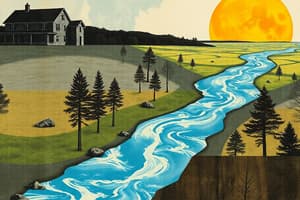Podcast
Questions and Answers
What is the primary source of freshwater on Earth?
What is the primary source of freshwater on Earth?
- Rivers and lakes
- Groundwater (correct)
- Atmospheric water vapor
- Wetlands
What is the process by which water vapor in the air cools and changes back into liquid water?
What is the process by which water vapor in the air cools and changes back into liquid water?
- Runoff
- Condensation (correct)
- Evaporation
- Precipitation
What is the term for water that flows over land and into bodies of water?
What is the term for water that flows over land and into bodies of water?
- Evaporation
- Runoff (correct)
- Precipitation
- Infiltration
What is a major cause of water scarcity?
What is a major cause of water scarcity?
What is the term for collecting and storing rainwater for later use?
What is the term for collecting and storing rainwater for later use?
What is the primary role of water in ecosystems?
What is the primary role of water in ecosystems?
What is the term for treating and reusing wastewater?
What is the term for treating and reusing wastewater?
What is the effect of water scarcity on food production?
What is the effect of water scarcity on food production?
What is the role of water in human health?
What is the role of water in human health?
Flashcards are hidden until you start studying
Study Notes
Water Resources
Definition
- Water resources refer to the freshwater available on Earth, including rivers, lakes, wetlands, groundwater, and atmospheric water vapor.
Types of Water Resources
- Surface Water: lakes, rivers, wetlands, and reservoirs
- Groundwater: water stored beneath the Earth's surface in aquifers
- Atmospheric Water: water vapor in the air
Water Cycle
- Evaporation: water evaporates from oceans, lakes, and rivers into the atmosphere
- Condensation: water vapor cools and condenses into clouds
- Precipitation: water falls back to Earth as rain, snow, or hail
- Runoff: water flows over land into bodies of water
- Infiltration: water seeps into soil and becomes groundwater
Water Scarcity
- Causes:
- Climate change
- Population growth
- Urbanization
- Agriculture and industry
- Effects:
- Water shortages
- Food insecurity
- Social and economic impacts
Water Management
- Conservation: reducing water waste and increasing efficiency
- Water Harvesting: collecting and storing rainwater for later use
- Water Recycling: treating and reusing wastewater
- Water Allocation: distributing water among competing users
Importance of Water Resources
- Ecosystems: supporting biodiversity and ecosystem services
- Food Security: irrigating crops and supporting agriculture
- Human Health: providing drinking water and sanitation
- Economic Development: supporting industries and energy production
Water Resources
- Freshwater available on Earth includes rivers, lakes, wetlands, groundwater, and atmospheric water vapor.
Types of Water Resources
- Surface water includes lakes, rivers, wetlands, and reservoirs.
- Groundwater is stored beneath the Earth's surface in aquifers.
- Atmospheric water refers to water vapor in the air.
Water Cycle
- Evaporation occurs when water evaporates from oceans, lakes, and rivers into the atmosphere.
- Condensation occurs when water vapor cools and condenses into clouds.
- Precipitation occurs when water falls back to Earth as rain, snow, or hail.
- Runoff refers to water flowing over land into bodies of water.
- Infiltration occurs when water seeps into soil and becomes groundwater.
Water Scarcity
- Causes of water scarcity include climate change, population growth, urbanization, agriculture, and industry.
- Effects of water scarcity include water shortages, food insecurity, and social and economic impacts.
Water Management
- Conservation involves reducing water waste and increasing efficiency.
- Water harvesting involves collecting and storing rainwater for later use.
- Water recycling involves treating and reusing wastewater.
- Water allocation involves distributing water among competing users.
Importance of Water Resources
- Water resources support ecosystems and biodiversity.
- Water resources are essential for food security and agriculture.
- Access to clean water is crucial for human health and sanitation.
- Water resources support economic development, industries, and energy production.
Studying That Suits You
Use AI to generate personalized quizzes and flashcards to suit your learning preferences.




